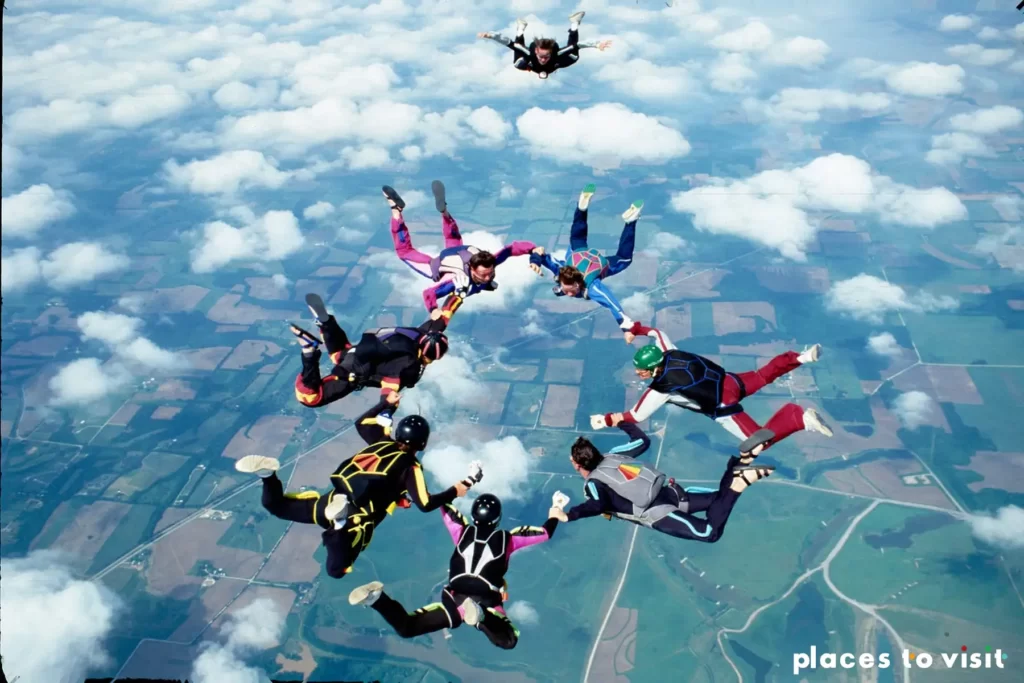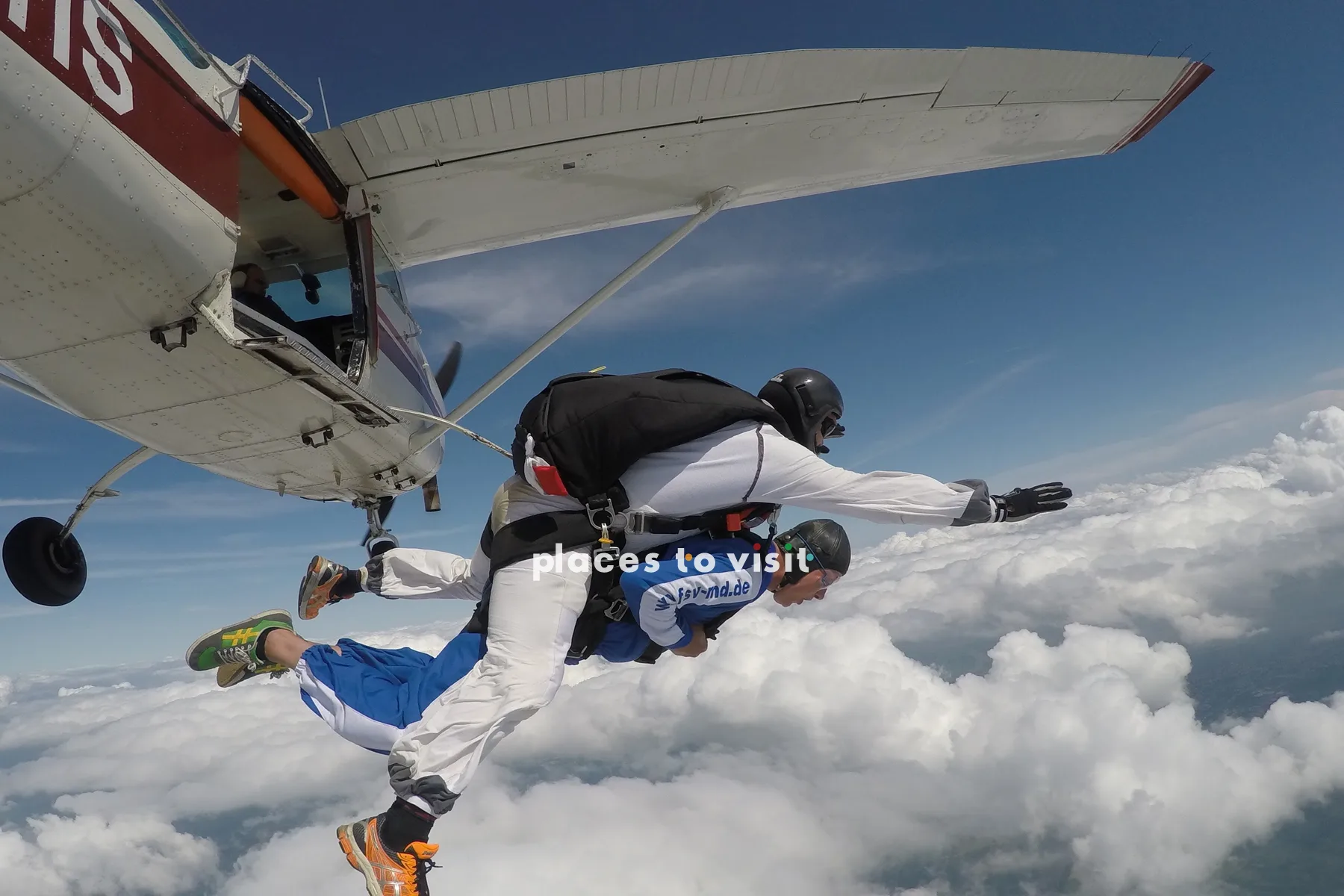If you are an adrenaline junkie looking for an adventurous activity, skydiving might be the perfect fit for you. It’s an incredible experience that involves free-falling from thousands of feet above the ground while enjoying the breathtaking scenery around you. The United States has numerous skydiving locations, and with this guide, we’ll take you through everything you need to know about skydiving in the US before you take the leap.
What is Skydiving?

Skydiving is an extreme sport that involves jumping from an airplane and free-falling before deploying a parachute to slow down and land safely on the ground. Skydiving is often considered a bucket-list experience and is popular among thrill-seekers worldwide. In the United States, skydiving has become an increasingly popular activity with over 3 million jumps per year.
Types of Skydiving
Tandem Skydiving

Tandem skydiving is the most common type of skydiving for beginners. It involves jumping with an experienced instructor who is attached to the student via a harness. The instructor guides the student through the entire process, from exit to landing.
Solo Skydiving

Solo skydiving, as the name suggests, involves jumping alone from an airplane after completing the necessary training. Solo skydiving is not recommended for beginners, and most drop zones require a minimum number of tandem jumps before allowing students to jump solo.
Accelerated Freefall (AFF)

Accelerated Freefall is a training program that teaches students how to skydive solo. It involves jumping from an airplane with two instructors who provide hands-on guidance through the jump.
Static Line Skydiving

Static Line skydiving is an alternative training program to AFF. Instead of jumping with two instructors, the student’s parachute is automatically deployed by a static line attached to the aircraft.
Skydiving Regulations and Safety
Skydiving is a high-risk activity, and as such, it’s essential to adhere to strict regulations and safety protocols.
Federal Aviation Administration (FAA) Regulations
The Federal Aviation Administration is responsible for regulating skydiving operations in the United States. The FAA establishes and enforces safety standards for skydiving equipment, aircraft, and operators.
United States Parachute Association (USPA) Regulations
The United States Parachute Association is the governing body for skydiving in the United States. The USPA establishes training and safety standards for skydivers and provides oversight for skydiving operations.
Top Skydiving Locations in the US
The United States has numerous skydiving locations, but some stand out for their incredible scenery and facilities.
California

California has numerous skydiving locations that offer stunning views of the state’s diverse landscape. Some of the most popular skydiving destinations in California include Lake Elsinore, Perris, and San Diego. Skydiving centers in California offer a variety of experiences, from tandem jumps for beginners to advanced training programs for experienced jumpers. Skydivers can enjoy views of the Pacific Ocean, mountain ranges, and scenic valleys as they free-fall towards the ground. California’s year-round mild climate and modern facilities make it an ideal destination for anyone looking to experience the thrill of skydiving.
Florida

Florida is another popular skydiving destination. With year-round warm weather, Florida offers ideal skydiving conditions for beginners and experienced jumpers alike. Skydiving centers in Florida are known for their modern facilities and experienced instructors.
Texas

Texas is home to several top skydiving destinations, including Austin and Dallas. Skydiving centers in Texas offer breathtaking views of the state’s stunning landscape, including rolling hills, mountains, and lakes.
Arizona

Arizona is a popular skydiving destination due to its dry climate and clear skies. Skydiving centers in Arizona offer incredible views of the Grand Canyon and the state’s rugged landscape.
Hawaii

Skydiving in Hawaii offers a unique experience, with stunning views of the Pacific Ocean and the state’s volcanic landscape. Hawaii has several skydiving centers, with options for both tandem and solo skydiving.
How to Prepare for Skydiving
Skydiving is a physically and mentally demanding activity. It’s essential to prepare yourself before your jump to ensure a safe and enjoyable experience.
Physical Requirements

Skydiving has specific physical requirements that must be met. These include being at least 18 years old, meeting weight restrictions, and being in good health.
Mental Preparation

Skydiving can be a nerve-wracking experience, especially for first-time jumpers. It’s essential to mentally prepare yourself before your jump by understanding the risks involved and the safety measures in place.
What to Wear

Skydiving requires specific clothing to ensure safety and comfort. You should wear comfortable, non-restrictive clothing and sturdy, closed-toe shoes.
What to Bring

Skydiving centers will provide all necessary equipment, including a jumpsuit, harness, helmet, and goggles. However, it’s always a good idea to bring a water bottle and a snack to stay hydrated and energized.
The Skydiving Experience
Skydiving involves several stages, each with its unique sensations and experiences.
The Pre-Jump Preparation

Before your jump, you’ll receive a briefing from your instructor on safety procedures and how to position your body during freefall. You’ll also be fitted with your jumpsuit, harness, and other necessary equipment.
The Flight and Ascent

You’ll board the plane with your instructor and other jumpers and ascend to the desired altitude. During the ascent, you’ll have time to take in the stunning views and mentally prepare for your jump.
The Jump and Free-Fall

Once you’ve reached the desired altitude, you’ll exit the plane with your instructor and experience the exhilarating sensation of free-falling. You’ll reach speeds of up to 120 mph as you fall towards the ground.
The Parachute Descent and Landing

At a designated altitude, your instructor will deploy the parachute, and you’ll enjoy a serene and peaceful descent towards the ground. Your instructor will guide you to a safe landing, and you’ll experience a rush of adrenaline and a sense of accomplishment.
Conclusion
Skydiving is an incredible experience that offers a unique blend of adventure and adrenaline. With numerous skydiving locations throughout the United States, there’s no excuse not to take the leap. By following the regulations and safety protocols, and mentally and physically preparing yourself, you can experience the thrill of free-falling while enjoying the stunning scenery from above.
FAQs
What is the minimum age requirement for skydiving in the United States?
The minimum age requirement for skydiving in the United States is 18 years old.
What should I wear for skydiving?
You should wear comfortable, non-restrictive clothing and sturdy, closed-toe shoes.
What is the difference between tandem and solo skydiving?
Tandem skydiving involves jumping with an experienced instructor, while solo skydiving involves jumping alone after completing the necessary training.
Is skydiving safe?
Skydiving is a high-risk activity, but when proper regulations and safety protocols are followed, it can be a safe and enjoyable experience.
What happens if the parachute doesn’t open?
Skydivers wear a backup parachute as a safety precaution in case the primary parachute fails to open. In the rare event that both parachutes fail, the skydiver would use a reserve parachute or a backup device known as a “skyhook” to deploy the reserve parachute automatically.





Leave a reply